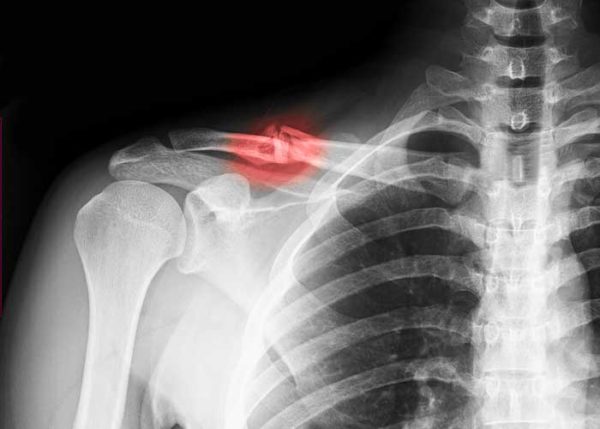Clavicle Fracture Specialist

A clavicle or collar bone fracture can occur from a fall, trauma, work injury or from a direct blow, experienced during work or a sports collision. Common symptoms of a fractured clavicle include sharp pain at the time of injury and difficulty with pain when moving the arm. Collar bone fracture specialist Doctor Riley J. Williams provides diagnosis as well as surgical and nonsurgical treatment options for patients in Manhattan, Brooklyn, New York City and surrounding areas who have sustained a clavicle injury or broken collarbone. Contact Dr. Williams’ team today!
What is a clavicle fracture?
The clavicle (collarbone) is a long s-shaped bone that connects the upper limb to the thorax. Together, the clavicle and the scapula (shoulder blade) form the shoulder girdle. The clavicle is often broken when the shoulder experiences trauma such as a direct blow or a fall onto an outstretched arm. Clavicle fractures are common, and account for 5% of all adult bone fractures. Dr. Riley J. Williams, orthopedic shoulder specialist serving patients in Manhattan, Brooklyn, New York City, NY and surrounding areas, has the knowledge and understanding, as well as substantial experience, in treating patients who have experienced a clavicle fracture.

Are there different types of clavicle fractures?
Classification of clavicle fractures is based on the anatomical location of the fracture, as follows:
- The fractured portion of the clavicle occurs in the middle of the bone; this area is the most common location of a break. If the bones remain in the correct anatomical position with minimal displacement, midshaft fractures can be treated without surgery.
- Lateral/Distal. The fractured portion of the clavicle occurs at the point furthest away from the body’s midline near the top of the scapula. Surgery may be necessary depending on the location of the fracture and the associated bony displacement.
- The fractured portion of the clavicle occurs at the point closest to the neck. These fractures are rare and account for approximately 2-4% of all clavicle fractures.
Are there certain populations more at risk for a clavicle fracture?
Although the majority of clavicle fractures are the result of a traumatic event, there are certain groups of individuals that are at a higher risk of experiencing a clavicle fracture. They are as follows:
- Children and Teens. The bones of individuals between the ages of 10 and 19 are still growing and thus have a lower density. These factors make bones more susceptible to fracture.
- Male athletes who participate in contact sports or high-impact activities, such as football, soccer, or wrestling, are three times more likely to experience a clavicle fracture.
- Older Adults. The density of bones decreases with the natural aging process and even minor traumas can result in a clavicle fracture.
What are the symptoms of a clavicle fracture?
A sharp pain of the clavicle immediately following an injury is the most common complaint of a clavicle fracture, although symptoms can vary depending on the severity of the injury. Other common symptoms of a clavicle fracture include:
- Obvious visual deformity of the clavicle
- Pain with arm movement
- Pain, bruising, redness, and swelling of the affected clavicle
- Difficulty with rotating or lifting the affected arm
- Downward shoulder sag
- Shoulder stiffness
How is a clavicle fracture diagnosed?
A comprehensive medical history will be obtained, and Dr. Williams will perform a thorough physical examination. An x-ray of the affected clavicle will be completed to confirm the diagnosis. Additional diagnostic testing, such as magnetic resonance imaging (MRI) scan or CT scan may be requested to rule out any damage to the other structures within the shoulder girdle, and to better understand the morphology of the fractured clavicle.
What is the treatment for a clavicle fracture?
Non-surgical treatment:
If a patient experiences a minor clavicle fracture that did not result in bony displacement, conservative therapies can be effective in resolving symptoms during the healing process. The affected arm will be placed in a sling to keep the clavicle in an acceptable position while healing. A combination of rest, ice, and non-steroidal anti-inflammatory medications (NSAIDs) is recommended for pain and inflammation management. When the pain and inflammation subside, physical therapy is encouraged to restore strength to the shoulder girdle.
Surgical treatment:
Athletic or high demand individuals may be best treated with surgery for clavicle fractures. Clavicle fracture surgery enable the surgeon to achieve anatomic positioning of the affected bone. Shortening of the clavicle after nonoperative treatment may result in anterior displacement of the scapula and chronic posterior shoulder pain. Other circumstances such as failed conservative therapy, a dislocated clavicle, excessive fragment displacement, or open fractures should also be considered for surgical intervention. The clavicle fracture repair (open reduction and internal fixation) procedure utilizes special plates and screws to realign and fix the bone fragments in their proper position.
This procedure is typically done on an outpatient basis using light sedation and regional anesthesia. Most patient will require a sling for approximately two weeks. Home based motion exercises are start immediately following surgery. Formal physical therapy starts approximately one week after surgery. Bony healing usually occurs 6-8 weeks after surgery. Most patients will require some physical therapy for 2-3 months following this procedure to achieve a full recovery.
For more information on clavicle fractures, or the excellent treatment options available, please contact the office of Dr. Riley J. Williams, an orthopedic shoulder specialist serving Manhattan, Brooklyn, New York City, NY and surrounding areas.